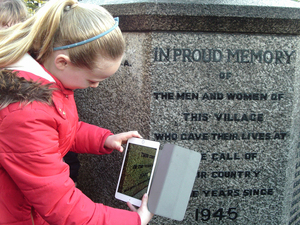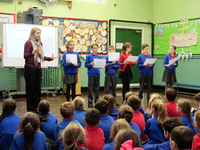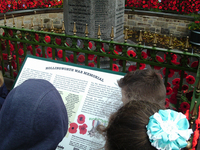- County name: Greater Manchester
- Group/School name: Hollingworth Primary School
- Age group: 5 - 11
- Group type: Year 6
Following a very successful visit in May 2018, Friends of Hollingworth and Hollingworth Primary School requested a repeat visit for November 2018. The new year 6 class would be working on a project about the centenary of the First World War, as the previous year 6 class had done, and Friends of Hollingworth and the class teacher were keen for the pupils to engage with and find out more about their war memorial. As part of the project an information board was created and is now located near the war memorial. On the board is a QR code which links to an audio piece created by the current year 6 about the men from Hollingworth who went to war between 1914 and 1918 and the creation of the war memorial.
The visit began with an assembly for key stage 2 about the centenary of the Armistice. This began by looking at the events from the summer of 1918 onwards which led to the signing of the Armistice. Pupils were asked to consider how people at home felt when they heard the news that the Armistice had been signed and the fighting had stopped. The events which took place in the years following the end of the Great War including the Paris Peace Conference, the signing of the Treaty of Versailles, the introduction of the two minute silence in 1919 and the creation of the poppy appeal in 1921 were then shared with pupils. It was also established that during this time there was a wave of memorialisation throughout the UK as people wanted to remember the sacrifice made by so many. Local war memorials were shown to pupils to highlight the individuality and variety of the memorials erected as a result of the decisions made by local war memorial committees. The assembly was attended by the Civic Mayor of Tameside who was interested to find out more about the work which pupils had been doing as part of the project.
The rest of the visit was spent working with year 6. The session immediately after assembly focused on what are war memorials. Pupils created their own definitions for what a war memorial is and were shown a range of local examples. The number of war memorials in the UK, when the majority were created and why was also discussed. Problems facing war memorials today were highlighted to provide a purpose for the condition survey that pupils would carry out in the second half of the morning.
Following a short break, pupils were shown the condition survey which they would be carrying out when they visited Hollingworth war memorial, www.warmemorialsonline.org.uk/memorial/253678. Upon arrival at the memorial, pupils were asked to describe what they could see. Key observations which were discussed included the First World War inscription which contains the Ode of Remembrance by Laurence Binyon, the reference to the memorial being created by public subscription in 1925 and the names of three civilians who were killed by a German bombing raid in 1942. Pupils then carried out the condition survey in 3 expert teams. Each team took photographs to provide evidence for the observations they made.
Back in the classroom, the pupils shared the observations made while carrying out the condition survey. These were brought together and uploaded to the War Memorials Online, www.warmemorialsonline.org.uk/report/253678/view/condition/206722. Friends of Hollingworth, who have been instrumental in ensuring necessary works have been carried out to the memorial, were delighted to find out that the pupils gave the memorial a condition level of ‘good’. This was an improvement on the ‘fair’ that pupils gave in May. One of the main reasons for this was that the missing letters have now all been replaced so the legibility of the names and dedications are much improved.
The afternoon session focused on researching those named on the war memorial. Pupils worked in small groups to find out more about one or two of ten men that had been pre-selected. Through research that had been carried out by members of Friends of Hollingworth, there were photographs of each of the ten men that were being researched. These were shared with pupils once they had found out some information and helped them to relate more to the person they were researching. Pupils used the Commonwealth War Graves Commission ‘Find War Dead database’ to begin their research and continued it further using the Hollingworth 100 website. This has further information about each of the First World War fallen named on the memorial and also includes a map to show where each one lived.
It was wonderful to be able to work with Friends of Hollingworth and Hollingworth Primary School again. A very enjoyable day was had by all and the children were thoroughly engaged in all the activities. It is clear that all the work that has been done by the school and Friends of Hollingworth has inspired the pupils to take a real interest in those people from their village who were affected by the events of the First World War.





